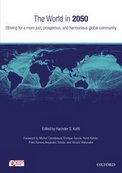The World in 2050: Striving For a More Just, Prosperous, and Harmonious Global Community

What will the world be like in 2050 and what kinds of efforts should be made to realize a more just, prosperous and harmonious global community? This book is a summary of the results of research by the Emerging Markets Forum (EMF), in which the world's high-level leaders debate issues facing emerging markets. It gives a long-term economic growth forecast to 2050, and based on this forecast, suggests policies and strategies that should be undertaken by political, economic and business leaders.
The editor is EMF Founding Director and Chief Executive Harinder S. Kohli. Twenty-five people from various countries contributed to the writing of the book.
The book comprises 18 chapters. Chapter 1 looks back at the state of the economy and society during the past half century. Chapter 2 introduces 10 megatrends that may influence the direction of the world economy: (1) demographics, (2) urbanization, (3) international trade, (4) the globalization of finance, (5) the rise of a massive middle class, (6) competition for finite natural resources, (7) climate change, (8) technological progress, (9) transformation of the global economy, and (10) violent non-state actors. Chapter 3 and the subsequent chapters discuss proposed measures and policies to deal with those trends and issues based on the latest research and debate in the international arena.
JICA Research Institute cooperated on both the research that forms the basis of this book and the Emerging Markets Global Forum 2015 held in Tokyo in November 2015.
At this general meeting held in 2015, JICA Vice President Hiroshi Kato led a session on food productivity and security, which is the topic of a chapter in this book, and Professor Akihiko Tanaka at the University of Tokyo (a former JICA president) led a session on urbanization. Also, at an event to mark the publication held in Paris on April 11-12, 2016, Kato spoke in the session "Beyond Growth: Achieving Sustainability." It was about sustainable development, a major pillar of this book.
This book looks back at the past 60 years, when most people in the world lived in abject poverty and suffered from hunger and disease, and it touches on the striking progress that has been made since. It says economic development is likely to remain favorable in the future. Most of the world would be urbanized, the middle class would expand, better education would be provided, people would enjoy a healthier life, and many people would be freed from absolute poverty, under this scenario. On the other hand, as the population aged throughout the world, overall growth rates would steadily decline, it says.
The book also presents a scenario in which many countries fall into the "middle income trap," where economic growth stagnates, resulting in political and social instability. In addition to the middle income trap, countries have a possibility to fall prey to "the resource curse" in which countries with a lot of natural resources are slow to develop economically, a failure to improve the credibility and quality of institutions, and an inability to create sufficient productive jobs, the book says.
While in the past advanced and emerging nations faced quite different problems, new challenges will be common to both advanced and emerging nations, the book predicts. As examples, it mentions the disparities in opportunities and income, the intense conflict over natural resources including water, the needs of aging societies and the competition to survive in an increasingly globalized world.
Moreover, the book warns, because there are projected to be more rich countries and more middle-class consumers, unless there are technological breakthroughs or changes in the lifestyles of consumers around the world or both, the planet's ability to sustain human life may be exceeded.
Based on such future projections, this book says, "The political, economic and business leaderships must remain very vigilant against complacency and continuously enhance resilience to shocks (external as well as domestic)."
Content:
List of Figures, Boxes, Tables, and Annexures
List of Acronyms
Foreword
Acknowledgments
Overview
1: Introduction and Historical Context
2: Global Megatrends
3: Demographics and Urbanization
4: Reforming the International Monetary System: A Sequenced Agenda
5: Governance of the Global Economic, Financial, and Monetary System
6: Emerging Markets Finance to 2050
7: Where will Emerging Markets Stand in Global Trade?
8: Emerging Markets and Climate Change: Protecting and Enhancing Prosperity
9: Crop Yields and Food Security in an Increasingly Affluent World
10: Water: A Motor and a Precondition for Sustainable Development in Emerging and Developing Economies
11: Potential Technological Landscape
12: Alternative Long-term Scenarios
13: The State of Global Governance: An Assessment
14: The Future of Violent Non-state Actors
15: Eradicating Poverty, Reducing Inequality, and Promoting Sustainable Development
16: The Ultimate Objective of the Development Process: Pursuit of Material Wealth versus Societal Well-being
17: Interlude: Changing Lifestyles to Sustain Prosperity for All
18: Global Partnership: A New Leitmotif for an Interconnected World
Epilogue: Facing Global Challenges Between Now and 2050
Annex 1: Classification of Countries into Nine Groups
Annex 2: Projection Methodology
Annex 3: Additional Regional and Country-level Results
Annex 4: Assessment of Long-term Fiscal and Current Account Sustainability
References
scroll